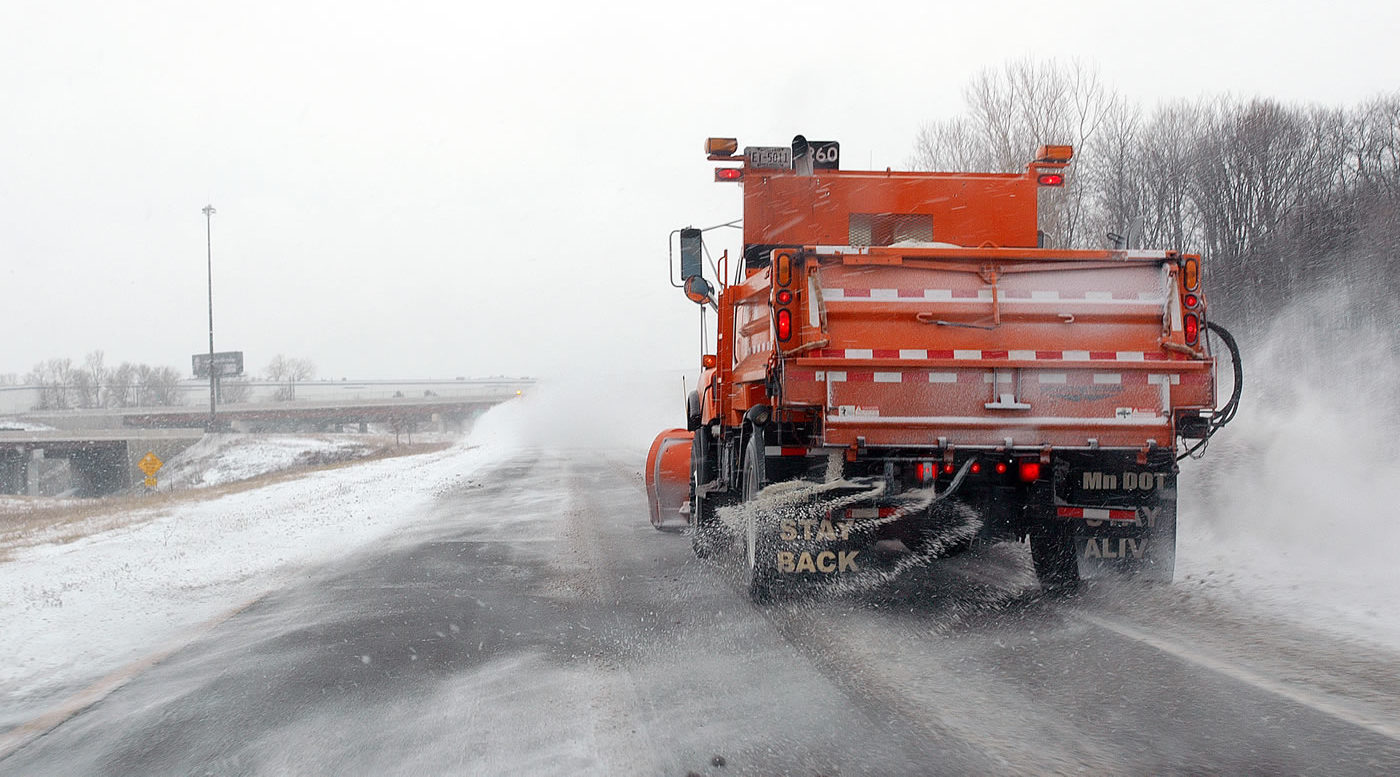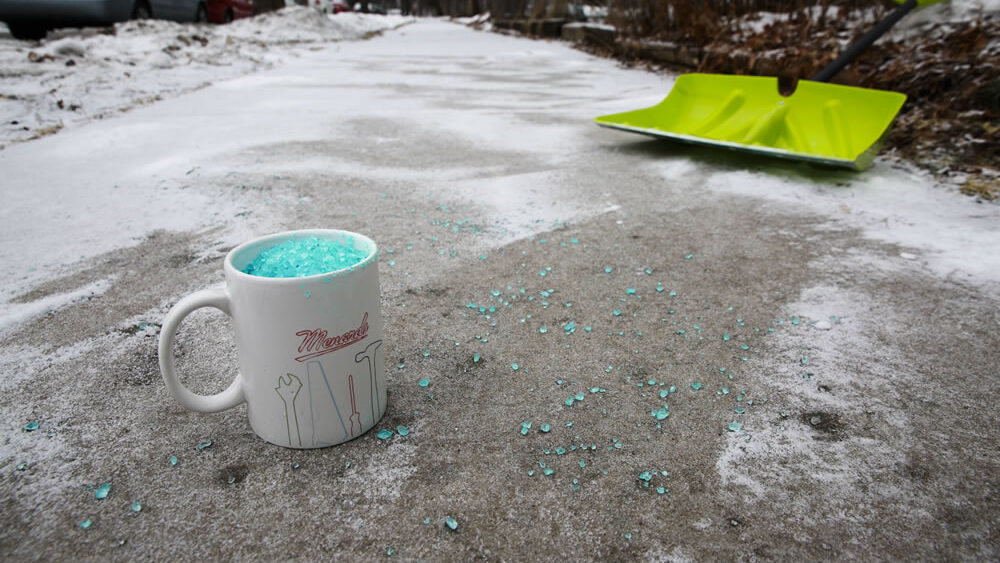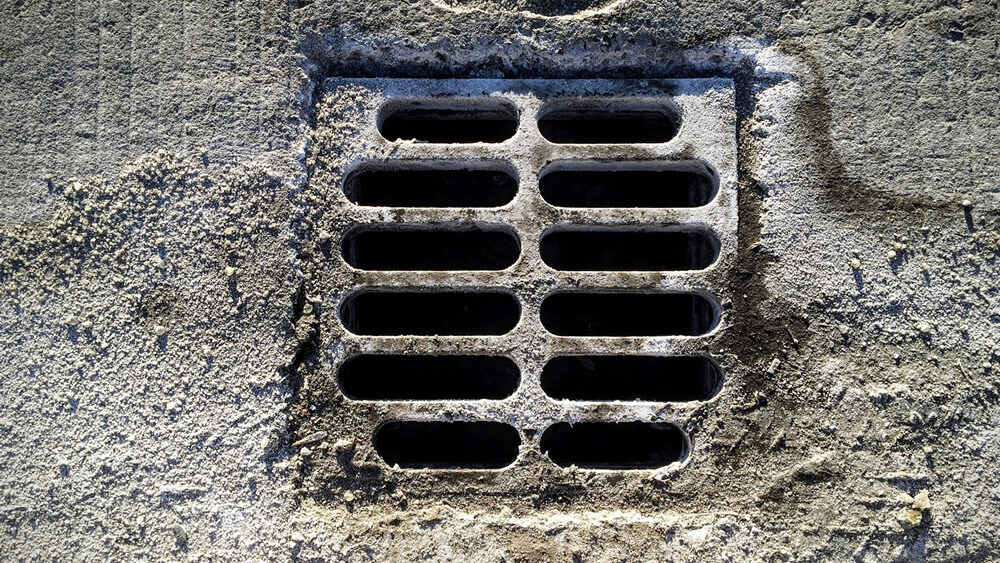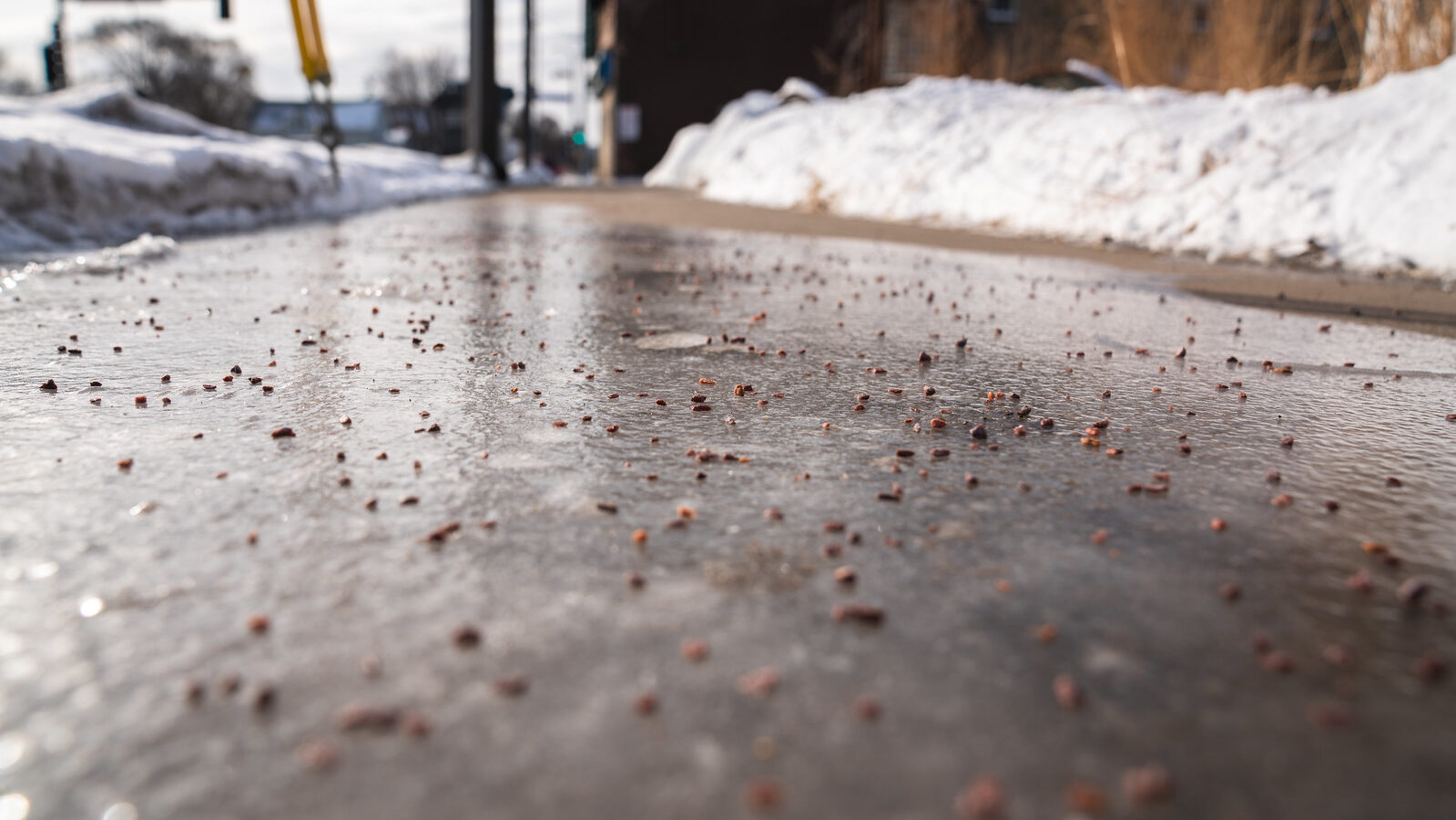Did you know that many Minnesota lakes and rivers are contaminated with chloride? This toxic chemical comes from the salt and deicers we use to keep ice off our roads in winter. Although they make it easier to get from point A to point B, we pay a big environmental price for using these chemicals to melt the ice on our roads.
Chloride is virtually impossible to remove from a waterbody. Once it’s there, it’s there for good. Just one teaspoon of salt contains enough chloride to pollute five gallons of water forever. And according to the Minnesota Pollution Control Agency, we apply an estimated 365,000 tons of it in the Twin Cities metro area each year. Research shows that 78 percent of that salt is either transported to groundwater or remains in the local lakes and wetlands.
Smart salting techniques can help reduce chloride pollution. In recent years, public works agencies began providing their snow plow crews with smart salting training and tools to help minimize chloride’s impact on the environment. You can do your part at home by following these simple tips for pollution-free snow and ice removal.

Shovel, Scrape, or Sweep — and Repeat
If possible, shovel early and often during a snowstorm. The sooner you get to shoveling, the less time the snow has to become compacted by people walking or driving on it. It might sound obvious, but the more snow you remove by shoveling or snow-blowing, the less compacted snow and ice you’ll have to deal with later.
Consider adding some new tools to your snow-removal arsenal. Although your trusty plastic shovel might work most of the time, your local hardware store is likely to carry a variety of push shovels, scoop shovels, ice chisels, and ice scrapers. There are many types of snow, slush and ice, so having a couple of different tools on hand never hurts.
Be creative! Use what you have around your house. For example, a broom might be a perfect way to clear light, powdery snow off of a walkway.

If It’s Too Cold, Don’t Use Salt
Extreme cold renders many salt and deicing chemicals useless. And unfortunately, winter weather in Minnesota follows a predictable pattern: the relatively warm temperatures during a snowstorm are typically followed by a big temperature drop.
Traditional road salt (sodium chloride) doesn’t work below 15 degrees F. Other products made of magnesium chloride, calcium chloride or urea have different melting temperatures, but the bottom line is that if it’s too cold, none of them will work.
When you think you need to apply salt, check the temperature first and read the label on your deicer product carefully to make sure it will work under the relevant weather conditions.

Use Sand or Grit to Provide Traction When It’s Too Cold
Sand or traction grit (also known as chicken grit) can help prevent slips and falls when temperatures are too cold for salt to work. Instead of melting the ice, sand and grit sit on top of the ice to provide traction. This makes it safer to walk or drive across icy pavement.
Use these products sparingly, however, as they can also be pollutants. Much like road salt, sand gets washed into storm drains in the spring and ends up adding sediment to rivers and lakes. Grit, because it is larger and coarser, tends to stay in place better than sand.
Always sweep up your sand or grit after the ice is gone. This will help prevent pollution, and you can save it and reuse it for the next storm.
Don’t bother mixing salt and sand, as they serve two completely different purposes. Sand only works if it sits on top of the ice. If it’s warm enough for the salt to work, then the sand isn’t doing anything besides sitting on wet pavement.

Use as Little Salt as Possible
More salt does not equal more melting. Try to apply the appropriate amount of product for the size of the area you’re treating. This will not only reduce waste and pollution, but also save you money.
In general, try to shoot for a 3-inch spread between salt granules. Try taking a few measurements initially to see how far your spread is; afterward, you’ll learn to eyeball it. If you can create a good spread pattern and memorize what it looks like, it will help you ensure that you use a reasonable amount of deicer every time. (If you’re willing to spend $10-$20, a hand spreader can make the job a lot easier.)
If you want to be more precise, try to apply 4 pounds of salt per 1,000 square feet of pavement. Use a tape measure to figure out the square footage of the area you’re treating and then use this ratio to calculate how much salt or deicer you should use for that area.
If it’s a warm day and the sidewalk is wet, don’t use any deicers. The sun is already doing the job for you, and throwing salt onto the ice isn’t going to hurry the process; it’s just going to send deicer down the storm drains.
Hire an MPCA-Certified Snow Removal Contractor
If you hire out snow removal for your property, choose a contractor who is certified by the Minnesota Pollution Control Agency (MPCA) in smart salting techniques, or encourage your contractor to become certified.
The MPCA maintains a list of contractors who have been trained and certified in eco-friendly snow and ice control best practices. You can find the list of certificate holders on the MPCA’s website.
Check out this helpful handout (PDF) from Nine Mile Creek Watershed District.
Salt and Deicer Comparison
Virtually all salt and deicer compounds and blends are damaging to the environment as well as harmful to concrete, metal and other materials. Some will work in lower temperatures than others. Here is a comparison of some common deicers and their various properties. (PDF Version) (JPEG Version)
| Melting Agent | Lowest Melting Temp.* | Things to Know |
| Urea | 20°F | Promotes algae growth in waterways; over-application can harm plants; relatively pet-safe; slow-acting |
| Sodium Chloride (NaCl) | 15°F | Harmful to plants; harmful to concrete; very corrosive to metal; cheap and abundant |
| Magnesium Chloride (MgCl2) | -10°F | Harmful to plants; corrosive to metal; relatively high cost |
| Potassium Acetate (KAc) | -15°F | Can cause surface slickness; lowers oxygen levels in waterways; biodegradable; relatively high-cost |
| Calcium Chloride (CaCl2) | -20°F | Corrosive to metal; leaves slimy residue; less harmful to concrete |
| Sand | No melting | Provides traction only; potential pollutant; can be swept up and re-used |
*Refers to pavement temperatures.
Downloads
You can download these resources for your own use or to teach others:
“Fight Snow and Ice, Pollution Free” Brochure (PDF)
“Fight Snow and Ice, Pollution Free” Brochure – Spanish Version (PDF)
“Fight Snow and Ice, Pollution-Free” Brochure – Somali Version (PDF)
“Pledge to be Salt Smart” Poster (PDF)
“Salt Smart Pledge” Quarter-Sheet Handout (PDF)
Videos
Master the art of pollution-free snow and ice removal with our winter maintenance videos on YouTube:
Share and enjoy this fun smart salting music video from The Hypoxic Punks:
Learn More
Minnesota Pollution Control Agency
Winter is finally here. Apply de-icing salt correctly to protect our lakes and streams (news release)
Water Pollutants: Chloride (web page)
Smart Salting Training (web page)
Chloride and Our Water: Monitoring the Mix (video)
City of Minneapolis
Salt Mini-Course Program (web page)
Nine Mile Creek Watershed District
Choosing a Deicer (PDF)
How to Hire a Contractor that Uses Less Salt (PDF)
Other Resources
Be Salt Wise! (website)